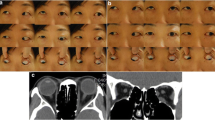Abstract
Background
Cyclic strabismus is a rare disorder in which strabismus and orthotropia regularly alternate over a period of mostly 48 h. It may occur spontaneously, upon squint surgery, or in association with lesions of the central nervous system. In most cases the deviations are convergent.
Methods
Clinical case report.
Results
A 34-year-old woman with bilateral recurrent ocular myositis for 2 years had developed cyclic vertical deviation 6 months after clinical remission. A hypotropia of the left eye alternated with an orthotropia, following a 48-h rhythm. Three months after recession of the inferior rectus muscle the alternating squint had disappeared.
Discussion
The aetiology of cyclic eye deviations, most of them occurring in a constant rhythm, is not known. The association with lesions of the central nervous system indicates a primary central dysregulation of a “biological clock”. Their well-known occurrence, however, after squint surgery and, as in the present case, after orbital myositis, suggests that alteration of peripheral structures may contribute to a central dysregulation. Squint surgery seems to be the treatment of choice, even in rare cases with vertical deviations.


Similar content being viewed by others
References
Gadoth N, Dickerman Z, Lerman M, Lavie P (1981) Cyclic esotropia with minimal brain dysfunction. J Pediatr Ophthalmol Strabismus 18:14–17
Metz HS, Jampolsky A (1979) Alternate day esotropia. J Pediatr Ophthalmol Strabismus 16(1):40–42
Metz HS, Searl SS (1984) Cyclic vertical deviation. Trans Am Ophthalmol Soc 82:158–166
Parlato CJ, Nelson LB, Harley RD (1983) Cyclic strabismus. Ann Ophthalmol 15(12):1126–1129
Pillai P, Dhand UK (1987) Cyclic esotropia with central nervous system disease: report of two cases. J Pediatr Ophthalmol Strabismus 24:237–241
Richter CP (1968) Clock-mechanism esotropia in children. Alternate-day squint. Johns Hopkins Med J 122:218–223
Riordan-Eva P, Vickers SF, McCarry B, Lee JP (1993) Cyclic strabismus without binocular function. J Pediatr Ophthalmol Strabismus 30:106–108
Roper Hall MJ, Yapp JMS (1968) Alternate-day squint. In: The First International Congress of Orthoptists, St. Louis. Mosby, London, p 262
Schmidt D, Mattheus S (1975) Zyklisches Einwärtsschielen. Klin Monatsbl Augenheilkd 167:835–839
Windsor CE, Berg EF (1969) Circadian heterotropia. Am J Ophthalmol 67:565–571
Author information
Authors and Affiliations
Corresponding author
Rights and permissions
About this article
Cite this article
Bau, V., Sievert, M., Roggenkämper, P. et al. Cyclic vertical deviation after ocular myositis and treatment by recession of the inferior rectus muscle. Graefe's Arch Clin Exp Ophthalmo 243, 1062–1065 (2005). https://doi.org/10.1007/s00417-005-1173-2
Received:
Revised:
Accepted:
Published:
Issue Date:
DOI: https://doi.org/10.1007/s00417-005-1173-2




